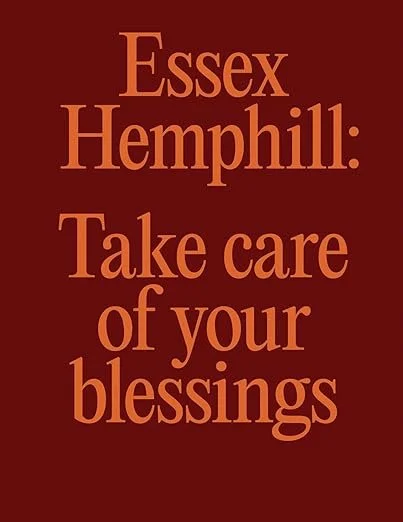The Phillips Collection memorializes one of D.C.’s finest artists
[Essex Hamphill in Los Angeles, 1992. Lyle Ashton Harris, Essex Hemphill, LA Contemporary Exhibitions, Los Angeles 1992. Chromogenic print, printed 2025. 15 x 20 15/16 in. © Lyle Ashton Harris]
Celebrating Essex Hemphill, poet, artist, activist
by Gregory Luce
Essex Hemphill was a force of nature. The multifaceted artist—poet, performer, visual artist, activist—is the subject of a powerful exhibition at the Phillips Collection, Essex Hemphill: Take Care of Your Blessings. Though small, the two rooms the show occupies are packed with artifacts: photos, videos, a large number of Hemphill's publications, books, posters, and more. These beautifully curated displays present the full range of Hemphill’s brief but highly productive and impactful career.
"Some of us bake wonderfully, write, paint, do any number of things, have facilities with numbers that others don't have. Those are your blessings. Some of us are very strong and candid and some of us are nurturers or combinations of all of those things. Just be aware of what your particular things are and nurture them and use them toward a positive way of living. That's simply what I meant.”—Essex Hemphill
As Jonathan P. Binstock, Vradenburg Director & CEO of The Phillips Collection, says, “This exhibition is a powerful tribute to Hemphill’s profound impact on shaping an interdisciplinary arts scene. It celebrates his contributions to poetry and activism while honoring Washington, D.C.’s significant cultural legacy in contemporary art, a legacy we are proud to highlight and support.”
Born in Chicago in 1957, Hemphill moved with his family to Washington, D.C., in early childhood. He began writing poetry as a young teenager, and by 1975 he was fully involved with the D.C. arts community, performing, editing journals, and beginning to publish his own work in chapbooks. One of his first public readings occurred in 1979 when noted Washington poet Ethelbert Miller arranged for him to read at Howard University’s library. Many performances followed around D.C. and elsewhere in the U.S. From this time until his untimely death from AIDS in 1995, Hemphill toured the world, collaborated with musicians and visual artists, established small presses and journals, and continued to publish widely.
No introductory essay can possibly do justice to Essex Hemphill’s extraordinary achievements, so it’s best to turn to the exhibition, which succeeds marvelously in conveying the scope and significance of his life and work.
Aside from his voluminous writings, Hemphill was a frequent collaborator with artists of all types. One of his most notable partners was Wayson Jones, another D.C.-area artist. Though known primarily as a painter, Jones teamed up with Hemphill for performances of poetry and music in such venues as the legendary d.c. space.
[Poster announcement for Wayson Jones and Essex Hemphill performance at d.c. space. Courtesy of Wayson Jones.]
Poet, filmmaker, and activist Marlon Riggs worked with Hemphill, including him in the film Tongues Untied, a groundbreaking exploration of Black homosexual identity and the bigotry that queer Black men face from both white and Black people.
[Poster for Tongues Untied by Marlon Riggs, featuring Essex Hemphill, 1989. Courtesy of Brian Freeman. © Signifyin’ Works.]
Beyond the writing and performance worlds, Hemphill was inspired by important visual artists and in turn, inspired a younger generation of artists. One of his contemporaries, Lyle Ashton Harris, created works that explored theses similar to those that Hemphill engaged, such as The Watering Hole, a series of photographs that question how Black culture is represented, consumed, and appropriated in media.
[The Watering Hole III, 1996. Chromogenic print. 35 1/2 x 29 in. The Museum of Modern Art, New York, Gift of Agnes Gund.]
And contemporary artist Tiona Nekkia McClodden has created an installation entitled The Brass Rail, which reimagines a rail used by patrons at the Brass Rail, a gay bar in Washington, D.C. that operated from 1967 to 1996.
[Tiona Nekkia McClodden, THE BRASS RAIL (After Essex) 2017. Brass with steel. 48 x 2 1/4 x 3 3/8 in. Courtesy of the artist.]
These are only a few examples of Hemphill’s influence in the artistic world of his—and our—time.
Take care of your blessings displays a large number of objects in a variety of media, artifacts of Essex Hemphill’s brief but blazing career. In addition, several videos give viewers a taste of Hemphill’s actual presence, his poetic and articulate speech. The final exhibit is not to be missed or overlooked: Hemphill speaking movingly about his experiences of bigotry and discrimination as both a Black and queer man.
The groundbreaking exhibition is on view until August 31 and is a must-see for anyone interested in D.C. art and cultural history, as well as those who wish to know more about the history of queer activism and its entanglement with the arts.
Essex Hemphill: Take Care of Your Blessings is on view at the Phillips Collection through August 31. The Phillips Collection is located at 1600 21st Street, NW, Washington, DC. Learn about hours, ticket prices, free and discounted admission opportunities and more here.
Gregory Luce is the co-founder and poetry editor of Washington Unbound. He has published six chapbooks. He lives in Arlington and serves as Poetry Editor of The Mid-Atlantic Review and writes a monthly column for the online arts journal Scene4.






